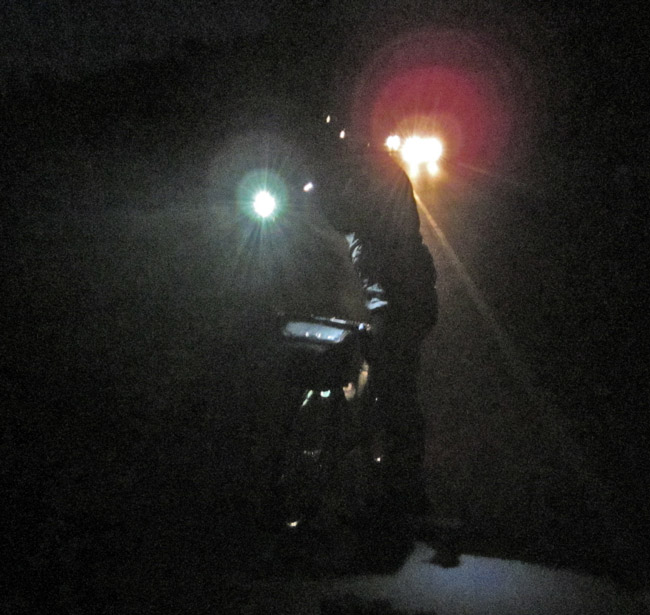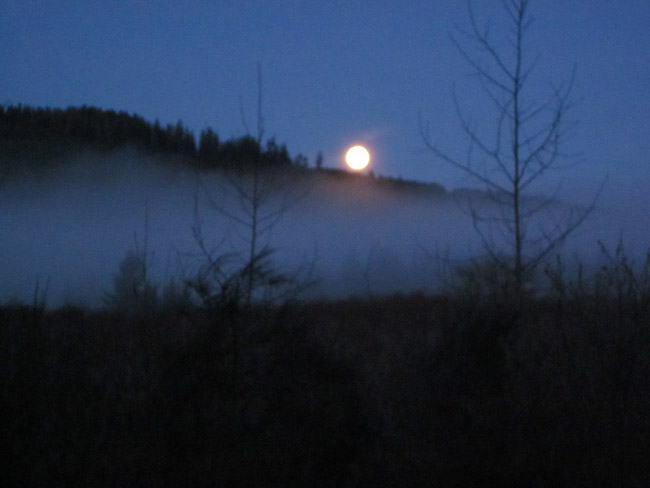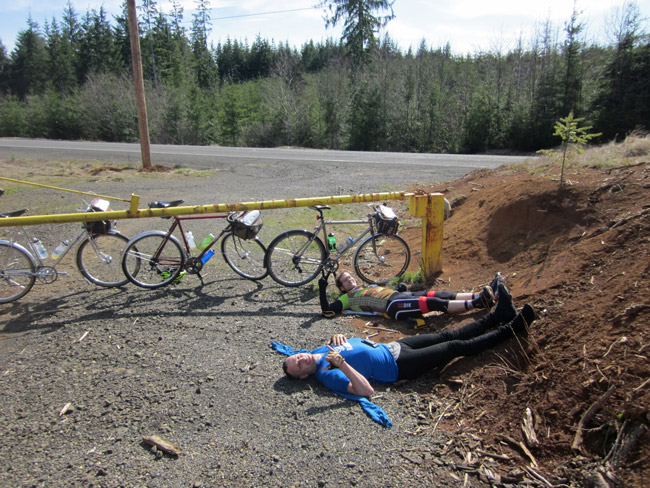Fleche 24-Hour Ride

Last weekend was the 24-hour Flèche team ride, traditionally held over the Easter weekend. The Flèche was officially inaugurated in 1947, but its origins go back further to the early 20th century when Vélocio gathered cyclotourists every spring in Provence. Riders from all over France rode their bikes to these events. In 1947, four riders from the Audax-Club Parisien (including “The Aunt” Paulette Porthault) decided to revive the tradition of riding to the gathering, and made it a formal event. The gatherings and rides to them continue to our day.
The Flèche formula is simple: Ride with a small group of friends non-stop for 24 hours on a course you design. You see how far you can go despite limited training and often inclement weather. Afterward, spend time with like-minded cyclotourists in a scenic location. There are some additional rules that help define the spirit of the event:
- maximum number of bicycles in a team is 5; at least 3 must complete the event.
- minimum distance is 360 km.
- you must come within 20% of the distance you had planned to cover.
- no stops longer than 2 hours.
- riders must complete at least 25 km during the last two hours. (Some riders used to ride only 22 hours, and count the last two hours as a stop.)
Last year, we had a wonderful Flèche. Despite a thunderstorm in the night and a car rally that closed some roads, we rode 534 km on wonderful backroads around the Olympic Peninsula. A full ride report is here.
This year, we used the same course. We had planned to field a full team of five riders, and even hoped to rope in a sixth (which would mean two riders were to be on a tandem), but in the end, various commitments enabled only the minimum of three riders to start: Steve Thorne, Hahn Rossman and myself. We submitted a “planned distance” of 500 km, which meant we could ride anywhere between 400 and 600 km to complete the event.

It all started well enough on a Friday evening, and we made good time to Port Gamble, our first control. We knew the store would be closed, but after just riding 29 km, there was no need for resupply.

We missed a turn and added about 15 km to our route, but that didn’t dampen our spirits. Hahn had a flat and discovered that his “event” tires were past their prime, but fortunately, it was to be the last puncture on this ride. Riding on backroads has more benefits than just quiet and beauty: there also is less glass and other debris to cause flat tires.
The full moon rose in the east as the sun set in the west. It was a spectacularly beautiful night. Across the Strait of Juan de Fuca, we saw the lights of Victoria in British Columbia. Then we headed into the hills. A twisty descent dropped us onto the beach again. In the moonlight, we saw the waves lap against the shore, and could even see the mountains of Vancouver Island across the Strait. It was very relaxing to ride with the full moon, as the transition from the beam of our lights to the surrounding darkness was very gradual. An owl flew alongside Hahn for a while as he climbed one of the many hills along this route.
The forecast was for a cold night, and it soon dropped below freezing. We were lucky that the rain we had seen on the horizon passed before we arrived. The roads started to get a little icy, but did not present a problem, as we were on a flat stretch. Ice formed on our handlebar bags where dew condensed and froze.
We found out once again that different cycling jackets perform very differently in cold conditions. My Gore Bike Wear jacket (and the three layered wool jerseys underneath) kept me dry and warm, whereas Hahn’s jacket is made by a company that promises “to celebrate the suffering unique to road riders.” It lived up to the promise: When we arrived in Forks for a brief stop at a convenience store, Hahn was covered in sweat, cold and much worse for wear.

As we left Forks in the morning twilight, the moon set behind a ridge. The fog in the valley was beautiful, but we were glad not having to ride through it during this chilly morning.

Seeing the sun rise after a complete night on the bike always exhilarating. As much as I enjoy riding at night, I celebrate the coming of a new, sunny day. The emotions of riding a bike are magnified during these long rides. We live to the fullest, sharing a great bond with our team-mates and our surroundings.

Soon, we reached the Pacific Ocean after riding across the Olympic Peninsula all night. For me, it always is an incredible feeling to have cycled from Seattle to this remote spot on the edge of the continent. Even by car, this is a long trip, and we just did it in a single night by bike! Thinking about the immensity of the ocean, about how on the other side is Japan, China, Russia and other places, all of that is simply awe-inspiring. I was thinking of Vélocio, the pioneer of randonneuring, who loved to ride to the Mediterranean in an all-night ride from Saint-Etienne and then walk along the beach, taking in the natural grandeur of his world.

Hahn still was suffering, and his thoughts were focused on the more prosaic: breakfast. We had planned to eat at the historic Lake Quinault Lodge, but being behind schedule, we stopped at Kalaloch Lodge instead. The food was good and we enjoyed a great view of the beach and the ocean. (Thank you to the National Park Service for providing such great alternatives to the diners and convenience stores that are the usual fare along America’s backroads.)

Fortified with eggs and potatoes, our spirits lifted, but the recovery from the cold night was not complete. A strong headwind slowed us further. We stopped again at Lake Quinault for lunch. The slow pace had taken a toll on all of us, and we felt sleepy. We took a half-hour nap on a nice spot on the lawn with a view of the lake and the Olympic Mountains beyond.
Things went better from there, but it was clear that instead of 530-600 km as planned, we could hope for no more than 430 km in the 24 hours. That meant riding the remaining 170 km to the finish after completing our 24 hour Flèche. On a good day we could readily deal with it, but when things aren’t going well, riding for 32+ hours instead of 26 is not a welcome undertaking.
After a short discussion, we came up with an alternative plan: In Aberdeen, we could take a short-cut that eliminated about 90 km from our route. We would ride 417 km, which still was within 20% of the 500 km we had “officially” planned, and also exceeded the required minimum of 360 km. This left only the rule of riding 25 km during the last 2 hours. We were about 28 km outside of Aberdeen, and 21:35 hours into the ride. If we stopped for another break, we could take our 22 hour control (which simply has you mark on your control card where you are 22 hours into the ride) almost exactly 25 km outside of Aberdeen.

So it was nap-time again. After our rest, we signed our cards for the 22-hour control and then rode into Aberdeen to officially complete our ride and eat dinner.
From there, we took the scenic route to Olympia, through the Willapa Hills.

The little roads winding through the hills were beautiful in the evening light. It was dark when we reached the gravel pass near Brooklyn, but our Edelux headlights allowed us to let the bikes roll on the descent. Descending gravel roads in the dark is a lot of fun, and this one was smooth and dry.
From the other side of the hills, we just had another 60 km to ride to the finish, where we arrived just before midnight. This Flèche did not turn out as we had planned, but it was a memorable adventure nonetheless. We’ll be back next year!
If you did a memorable Flèche ride, we’d love to publish your ride report in the Cyclos Montagnards Flèche Challenge.
Further reading:
- Our proposed route.
- A report on last year’s Fleche.
- Audax-Club Parisien Rules of the Flèche.
- Report from the first Flèche Vélocio (translated from French): Bicycle Quarterly Vol. 3, No. 1, p. 24.


